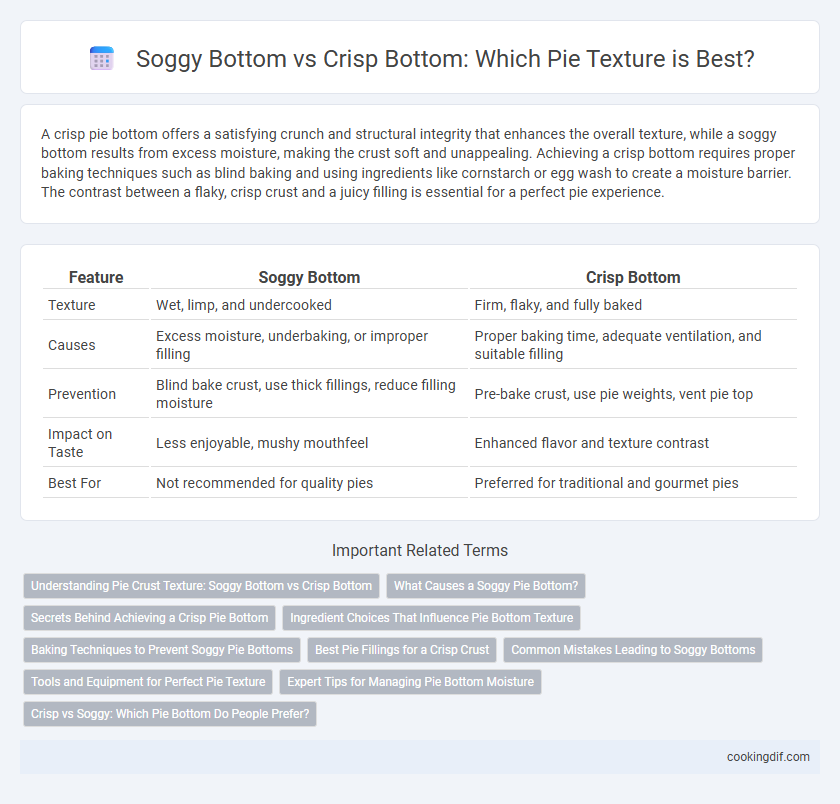A crisp pie bottom offers a satisfying crunch and structural integrity that enhances the overall texture, while a soggy bottom results from excess moisture, making the crust soft and unappealing. Achieving a crisp bottom requires proper baking techniques such as blind baking and using ingredients like cornstarch or egg wash to create a moisture barrier. The contrast between a flaky, crisp crust and a juicy filling is essential for a perfect pie experience.
Table of Comparison
| Feature | Soggy Bottom | Crisp Bottom |
|---|---|---|
| Texture | Wet, limp, and undercooked | Firm, flaky, and fully baked |
| Causes | Excess moisture, underbaking, or improper filling | Proper baking time, adequate ventilation, and suitable filling |
| Prevention | Blind bake crust, use thick fillings, reduce filling moisture | Pre-bake crust, use pie weights, vent pie top |
| Impact on Taste | Less enjoyable, mushy mouthfeel | Enhanced flavor and texture contrast |
| Best For | Not recommended for quality pies | Preferred for traditional and gourmet pies |
Understanding Pie Crust Texture: Soggy Bottom vs Crisp Bottom
A crisp bottom pie crust is achieved by using high-fat content like butter or shortening and pre-baking the crust to prevent moisture absorption from the filling. A soggy bottom results from inadequate baking time, excessive filling moisture, or lack of a barrier like an egg wash or blind baking. Proper techniques such as chilling the dough, using hot filling, and incorporating ingredients like cornstarch or flour help maintain a firm, flaky crust texture.
What Causes a Soggy Pie Bottom?
A soggy pie bottom typically results from excess moisture in the filling or improper baking techniques. Filling ingredients with high water content, such as fresh fruits, release steam during baking that can saturate the crust, preventing it from crisping properly. Using a pre-baked crust, blind baking, or applying a barrier like egg wash or flour can help achieve a crisp bottom by minimizing moisture absorption.
Secrets Behind Achieving a Crisp Pie Bottom
Achieving a crisp pie bottom relies on precise temperature control and proper dough preparation, including using cold butter and minimal handling to prevent gluten over-development. Blind baking with pie weights ensures an evenly cooked crust that resists sogginess from moist fillings like fruit or custard. Incorporating ingredients such as cornstarch in the filling and placing the pie on a preheated baking stone can further enhance a crisp, golden bottom texture.
Ingredient Choices That Influence Pie Bottom Texture
Using high-fat ingredients like butter or shortening creates a crisp bottom in pies by coating flour proteins and preventing excessive gluten formation, which ensures flakiness. Incorporating cold water and avoiding overmixing the dough helps maintain a tender, crisp crust, while adding sugar can enhance browning and crispness. Conversely, ingredients with higher moisture content, such as milk or eggs, often result in a soggy bottom by saturating the dough and weakening its structure.
Baking Techniques to Prevent Soggy Pie Bottoms
Achieving a crisp pie bottom requires precise baking techniques such as blind baking the crust before adding filling to prevent sogginess caused by moisture. Using a metal or glass pie dish enhances heat conductivity, ensuring even cooking of the crust. Incorporating ingredients like egg wash or sprinkling breadcrumbs or crushed cookies on the crust base absorbs excess moisture, maintaining a flaky texture.
Best Pie Fillings for a Crisp Crust
A crisp pie bottom is ideal for fillings with high moisture content, such as apple, cherry, or blueberry, as it prevents sogginess by creating a sturdy barrier against liquid seepage. Using techniques like blind baking and brushing the crust with egg wash or melted butter before adding the filling enhances flakiness and crispness. Fruit pies like classic apple cinnamon or mixed berry benefit most from these methods, ensuring a perfectly textured crust that holds up under juicy fillings.
Common Mistakes Leading to Soggy Bottoms
Common mistakes leading to a soggy pie bottom include underbaking the crust, using a filling that is too watery, and failing to pre-bake or blind-bake the crust. Improper oven temperature and not allowing the filling to cool before adding it can also result in moisture seeping into the crust. Using a metal pie pan or brushing the crust with egg wash or melted butter helps achieve a crisp bottom texture.
Tools and Equipment for Perfect Pie Texture
Using a metal pie pan ensures even heat distribution, promoting a crisp bottom crust, while glass pans retain moisture, often resulting in a soggy bottom. A baking stone or pizza stone absorbs excess moisture from the pie's base, helping achieve a golden, crunchy texture. Employing a pie shield or aluminum foil prevents overbrowning of the edges while allowing the crust to bake thoroughly for an ideal crispness.
Expert Tips for Managing Pie Bottom Moisture
Expert tips for managing pie bottom moisture emphasize the importance of using blind baking to achieve a crisp bottom crust by pre-cooking the pastry without filling. Applying a thin layer of egg wash or melted butter before adding the filling creates a moisture barrier that prevents sogginess. Choosing fillings with lower water content or thickening juicy fruits with cornstarch or flour also helps maintain a crisp, flaky pie bottom texture.
Crisp vs Soggy: Which Pie Bottom Do People Prefer?
Crisp pie bottoms are favored for their firm texture and rich, buttery flavor that enhances the overall pie experience, while soggy bottoms often result from underbaking or excess filling moisture, leading to a less desirable, mushy texture. Studies show that consumers generally prefer a crisp bottom, associating it with freshness and superior baking techniques. Achieving the perfect crisp crust involves using cold butter, blind baking, and proper venting to prevent sogginess and maintain structural integrity.
Soggy bottom vs crisp bottom for pie texture Infographic

 cookingdif.com
cookingdif.com